|
|
 |
 |
| On the scale of a city, the objects found in Susa reflect a more general trend in artistic production in the early centuries of the Islamic period. While the small stand and the pitcher show borrowings from the ancient decorative repertory, the blue and white ceramics and the metallic luster platter illustrate the development of specifically Islamic productions. Objects such as these from Susa, which testify to a range of ceramic techniques, give us an idea of the vitality of this flourishing art form. |
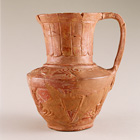 |


8th-9th century
Iran, Susa
Ceramic clay paste, molded decoration smoothed with slip
H.: 11.5 cm; Diam. of body: 8.5 cm
Musée du Louvre, Paris

© Photo RMN - ©Jean-Gilles Berizzi |
| In several respects, this pitcher recalls ancient models: it is similar in shape to ancient metallic pitchers; in material and decoration, it resembles Roman terra sigillata ware which is famous for the sheen and molded decoration made possible by the use of an ultra-refined clay. However, this item can definitely be attributed to the period in Susa's history subsequent to the Arab conquest, as there is a (sadly incomplete) Arabic signature under the base, beginning with the formula 'amal' ("work of ..."). |
|
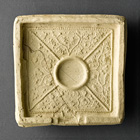 |


7th-8th century
Iran, Susa
Unglazed ceramic clay paste, molded decoration
H.: 2.6 cm; W.: 11.5 cm
Musée du Louvre, Paris

© Musée du Louvre/Raphaël Chipault. 2008 |
| The delicate little stand with its finely molded decoration is still something of a mystery. Although we have insufficient evidence to determine its function, we know the source of its decorative elements, which reflect the use of ancient designs in early Islamic art. The stand is framed by a broad rim, and has a molded circle in its center. The diagonals, which divide it into four sections, are emphasized by a plaited line that forms an indentation at the place where the rim is interrupted. Each section is decorated with different foliate scrolls: vine branches, pomegranates, acorns, bunches of grapes. The foliate scroll motif, borrowed from an ancient repertory that spread throughout Asia, allows us to date this object to the first centuries of Islam. |
|
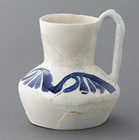 |


Late 8th-10th century
Iran, Susa
Ceramic clay paste, painted decoration on opaque glaze
H.: 12 cm; max. Diam.: 11.7 cm
Musée du Louvre, Paris

© Photo RMN - ©Jean-Gilles Berizzi |
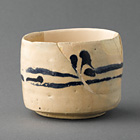 |


Late 8th-10th century
Iran, Susa
Ceramic clay paste, painted decoration on opaque glaze
H.: 8.1 cm; max. Diam.: 10.4 cm
Musée du Louvre, Paris

© Photo RMN - ©Jean-Gilles Berizzi |
| These two objects illustrate the production of blue and white decorated ceramics in the early centuries of Islam. Around the 750s, the potters tried to reproduce the whiteness of the Chinese porcelain that flooded the ports of Iran and Iraq. They made ceramics whose clay paste was coated with an opaque white vitreous layer, thereby inventing the technique now known in Europe as faience. The decoration, painted with cobalt oxide, reflects an Islamic art that had broken free of ancient models. The bowl has a line of pseudo-calligraphy. Writing—a decorative element in its own right in Islamic art—was sometimes adapted to form purely decorative pseudo inscriptions. The pitcher is decorated with stylized half palmettes and reflects a purely Islamic reinterpretation of ancient elements. |
|
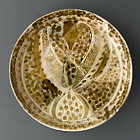 |


9th century
Iran, Susa
Ceramic clay paste, metallic luster decoration on opaque glaze
H.: 4.7 cm; max. Diam.: 25.8 cm
Musée du Louvre, Paris

© Musée du Louvre/Raphaël Chipault. 2008 |
| This platter is decorated with metallic luster—a major technique in Islamic art, that consisted of adding metallic oxides to the white surface of a piece. After firing, these oxides formed a decoration with shiny metallic reflections. The luster technique was highly complex and required great expertise in controlling the kiln temperature. It was used in Islamic art from the 9th to the 19th century, and underwent many variations. The platter shown here illustrates the polychrome luster technique. Different colors of luster could be obtained by varying the proportions of copper and silver in the metallic oxides. The decoration is strongly reminiscent of Mesopotamian lusterware, and is similar in many respects to that on pieces found at Kairouan in Tunisia. |
|
|

